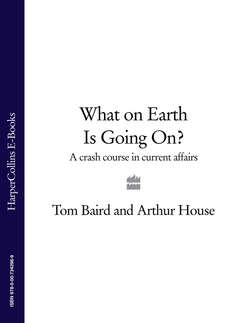Читать книгу What on Earth is Going On?: A Crash Course in Current Affairs - Arthur House - Страница 7
ОглавлениеAl-Qaeda
What is it?
Al-Qaeda (meaning ‘the Base’) is an international Sunni Islamist movement founded in 1988 by the Saudi Arabian Osama bin Laden. Since 1992 it has carried out terrorist attacks on civilian and military targets across the world in an extreme interpretation of jihad (see Islam), the Islamic doctrine of holy struggle. Most devastatingly, it was responsible for the attacks
on the World Trade Center and Pentagon on 11 September 2001, which claimed around 3,000 lives and injured 6,300.
How is it run?
The command structure and operational methods of al-Qaeda are a matter of some debate. Al-Qaeda has been known to operate cells (small groups of clandestine agents) in Western cities and to have local networks across the Muslim world (in Iraq and North Africa, for example). However, the extent to which these regional representatives are controlled by the central leadership is disputed; some claim that al-Qaeda is a coherent militant organisation, while others see it as a loosely defined concept, with a few core members providing ideology and inspiration for followers around the world. Despite this uncertainty, the ‘destruction of al-Qaeda’ was a key aim of George W. Bush’s ‘War on Terror’ and the US invasion of Afghanistan following the 9/11 attacks. What is left of al-Qaeda today is unclear, but its leaders are believed to be hiding in Pakistan’s tribal areas next to the Afghan border, where several other jihadi groups are based. Al-Qaeda is known to share training camps with these groups, such as the Pakistani-based Lashkar-e-Taiba, as well as fostering contacts with other militant Islamist movements such as the South-East Asian Jemaah Islamiyah.
What are al-Qaeda’s aims and beliefs?
Al-Qaeda aims to remove foreign, especially Western, influence from Muslim countries and establish a new Caliphate (an Islamic empire based on Sharia law—see Islam) across the Muslim world. Bin Laden and his followers are thought to be heavily influenced by the writings of Sayyid Qutb, a mid-20th-century Egyptian Islamist intellectual who
Apart from 9/11, which other attacks have been attributed to al-Qaeda?
1992: Hotel bombings in Aden, Yemen (2 killed, 7 injured)
1993: First World Trade Center bombing, New York, USA (6 killed, 1,042 injured)
1998: US Embassy bombings in Nairobi, Kenya (212 killed, around 4,000 injured) and Dar-es-Salaam, Tanzania (11 killed, 85 injured)
2000: Attack on the USS Cole, Aden harbour, Yemen (19 killed, 39 injured)
2003: Truck bombings in Istanbul, Turkey (57 killed, 700 injured)
2003-6: Attacks in Iraq on UN, US and Shi’ite targets by Abu Musab al-Zarqawi’s ‘al-Qaeda in Iraq’ (thousands killed and injured)
2007: Car bombings in Algiers, Algeria (roughly 90 killed, 350 injured)
2008: Danish Embassy bombings in Islamabad, Pakistan (6 killed, 24 injured)
advocated offensive jihad to rid the world of non-Muslim influences. He also declared that any Muslim not living under Sharia law is automatically an apostate (i.e. guilty of renouncing their faith), a crime punishable by death. This idea has been used by al-Qaeda to justify the killing of fellow Muslims. Bin Laden has been quoted as saying that Afghanistan under the Taleban regime of 1996-2001 was the ‘only Islamic country’ in the world.
What are its roots?
Whilst fighting against the Soviets in Afghanistan in 1984 for the CIA-funded Mujahedeen (see Afghanistan), Osama bin Laden co-founded the Maktab al-Khidamat (‘Services Office’), an organisation which raised funds and recruited foreign jihadis, or ‘Afghan Arabs’, for the war effort. In 1988 bin Laden split from Maktab al-Khidamat, taking with him a loyal following; this was the core of what would later become known as al-Qaeda. After the Soviet defeat in Afghanistan, bin Laden directed his jihad towards American targets. His fervent anti-American stance has been well known since 1990, when he publicly denounced his own country, Saudi Arabia, for allowing US forces on to its soil in order to repel Saddam Hussein’s invasion of Kuwait. From 1992-6 bin Laden and al-Qaeda operated out of Khartoum, the Sudanese capital, where they were joined by members of EIJ (Egyptian Islamic Jihad). EIJ’s leader Ayman al-Zawahiri subsequently became deputy leader of al-Qaeda. In 1996 bin Laden and al-Zawahiri were expelled from Sudan and granted a safe haven by the Taleban regime in the mountains of Afghanistan, which became al-Qaeda’s new headquarters. In 1998 bin Laden, al-Zawahiri and three others (as the ‘World Islamic Front for Combat Against the Jews and Crusaders’) issued a fatwa calling for the deaths of Americans and their allies, despite the fact that they did not possess the necessary Islamic qualifications to do so.
How is it funded?
Bin Laden is extremely rich himself, having been born into a prominent Saudi family, and he has close ties with wealthy Islamist sympathisers across the Muslim world. Funds are channelled to al-Qaeda from a variety of sources, including hawalas (small money-brokering operations), Islamic charities, fake companies, lightly regulated banking centres (e.g. Dubai and Liechtenstein) and commodities such as Angolan diamonds or Afghan opium, which can be transported easily and traded for cash or weapons. Identifying the sources of funding for al-Qaeda and other Islamic militant groups is a major aspect of counter-terrorism operations against them.
‘We love death. The US loves life. That is the difference between us two.’
OSAMA BIN LADEN, November 2001
